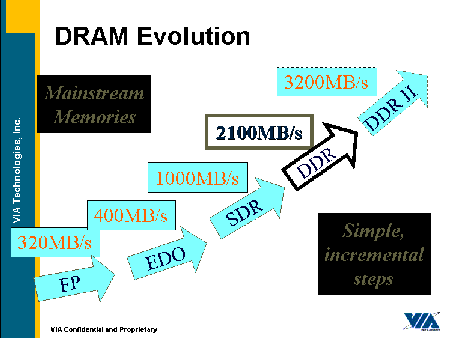Ace's Hardware meldt dat DDR-II, de opvolger van DDR SDRAM, niet gebaseerd zal zijn op de ESDRAM technologie van Ramtron / Enhanced Memory Systems, zoals zij begin augustus beweerden. Wel wordt er een low-latency versie van DDR-II ontwikkeld, die volgens de bronnen van Ace's gebruik zal maken van de ESDRAM principes. De andere technologie die in aanmerking komt voor de low-latency DDR-II standaard is Virtual Channel, dat bij toepassing in SDRAM chips marginaal sneller is gebleken dan normaal SDRAM. Volgens onafhankelijke studies van IBM en de universiteit van Maryland presteert E-DDR II beter dan VC DDR-II en is het in tegenstelling tot VC DDR-II in alle gevallen sneller dan normaal DDR II geheugen:
According to some of our best industry sources, it seems that the Low latency version of DDR-II will be based on EDRAM, and not on VC SDRAM. The child of Enhanced Memory Systems gains momentum and it is not a big surprise. E-DDR II performs, according to independent studies of IBM and the university of Maryland up to 22% better in SpecInt than DDR-II! According to the same studies, E-DDR II performs always better than DDR-II, while Virtual Channel performs worse in certain benchmarks.The beauty about the EDRAM concept is that it adds very little SRAM and thus die space to the chip, to be more exact only 1.4%!. Those SRAM buffers contain the row data, and the controller can read those buffers instead of the sense amps. While the SRAM buffers are read, the sense amps are free for precharge and refresh operations. In other words, those SRAM buffers can eliminate latencies like the precharge latency.
The SRAM buffer has a latency of 10ns, while a normal DRAM cell has a latency of 20 ns. It is a pity that we did not see any EDRAM on the market, because the 10ns could have provided us with CAS-1 SDRAM...
[EDIT] Ik (Floris) heb nog even een roadmap-plaatje van VIA toegevoegd, waarin vermeld wordt dat DDR-II gewoon als mainstream geheugen gezien wordt ![]() [EDIT]
[EDIT]


